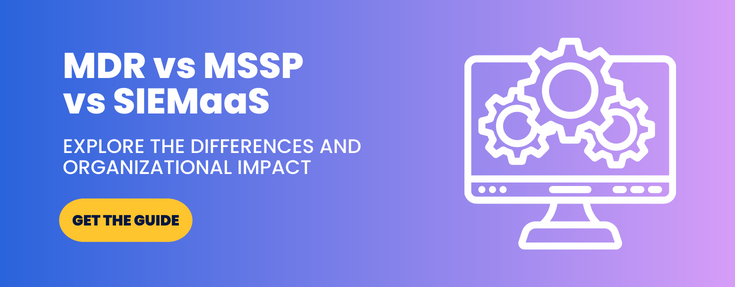SIEM Data: What is it and who owns it?

 By
Jason Miller
·
3 minute read
By
Jason Miller
·
3 minute read
Find out why the key question to ask your SIEM provider is: Will I have access to all of my SIEM data?
If there is one tool that all CTOs, CIOs, and CISOs need to start using right now, it has to be SIEM software.
SIEM stands for Security Information and Event Management.
It allows a company’s tech and IT department to effectively monitor and review activities within the IT environment. It also provides important insights that can be used to develop and improve cybersecurity efforts.
Most companies will use a SIEM service provider. These providers give them software to track their SIEM. When you are deciding which service provider to go with, there is one very important question that you need to ask:
Will I have access to all of my SIEM data?
Not sure why that’s such a key question? Read on to find out why!
What Is SIEM Data?
The SIEM data is all of the data and information that the software logs for you. This includes data that relates to the activity that the SIEM software tracks. The majority of SIEM platforms collect a historical log of data as well as tracking real-time events. The data might also cover vulnerabilities, anomalies, or individual incidents. Basically, this kind of data is any information that refers to any security information and event management.
Where Does SIEM Data Come From?
There are a variety of places where this kind of data will come from. You will be able to aggregate data from various sources, including databases, network, security related infrastructure, servers, firewalls, and antivirus systems, etc.
Once you have SIEM software from a subject matter expert service provider in place, you will be able to start collecting all of this kind of data from these sources. The software will also analyze the data to show you any trends or patterns. These trends provide insight into how you can improve and update your overall IT and cybersecurity posture.
What Should You Do With Your SIEM Data?
There are a lot of different ways to use and implement SIEM data throughout your IT network, systems and cybersecurity efforts. Here are just a few things you might want to use your SIEM data for.
Streamline All Of Your Compliance Reports
Once you start to gather a fair bit of data within your SIEM, you will find that it is much easier to start streamlining all of your compliance reporting. Just one SIEM server will collect a multitude of useful data that can quickly be turned into a complete report. These types of reports are extremely accurate and detailed.
Detect Incidents That Might Have Previously Gone Undetected
When you are collecting and logging SIEM data, it will be very easy to see if any anomalies pop up. These anomalies will likely have been caused by a security incident. Even though the incident might not have amounted to a complete breach or any loss of data, it’s still important that you are aware of them so that you can continue to protect your IT network from them. Prior to collecting SIEM data, there was no way that you would have been alerted to these kinds of anomalies. As a result, the incident might have gone completely unnoticed.
Handle All Incident Activities More Efficiently
In addition to detecting incidents, you will also be able to handle them more efficiently and effectively as well. By looking at trends and patterns in the data, you will be able to see the things that were the most effective at preventing incidents or handling them when they occurred. The data will show you the most likely route of any hacker or virus, so you can stay one step ahead of them.
SIEM Data Wrap UP
SIEM and the data that it provides is incredibly important to all organizations for ensuring cybersecurity and staying compliant. A reliable and reputable SIEM service provider will help you harvest a lot of data that you might not have already had access to. You will be able to use it in numerous ways to ensure your systems are secure.
If you don’t already use a SIEM service provider within your SOC team, it is worth considering. It will greatly improve your cybersecurity efforts and almost ever hack, virus, and data breach will be stopped in their tracks. This is good news for your company and all the customers and clients whose data you might have stored in your system.
BitLyft is a SIEM provider and offers competitive pricing. We have a world-class team of professionals who will guard your date and ward off cyberattacks before they can cause damage to your infrastructure.
Our services aim to provide you with a simple no-nonsense solution to keep your business safe from online threats. If you’d like to learn more, don’t hesitate to get in touch with us today to speak to one of our friendly representatives. We’ll help explain the services we offer and how they can be customized to your exact needs.

